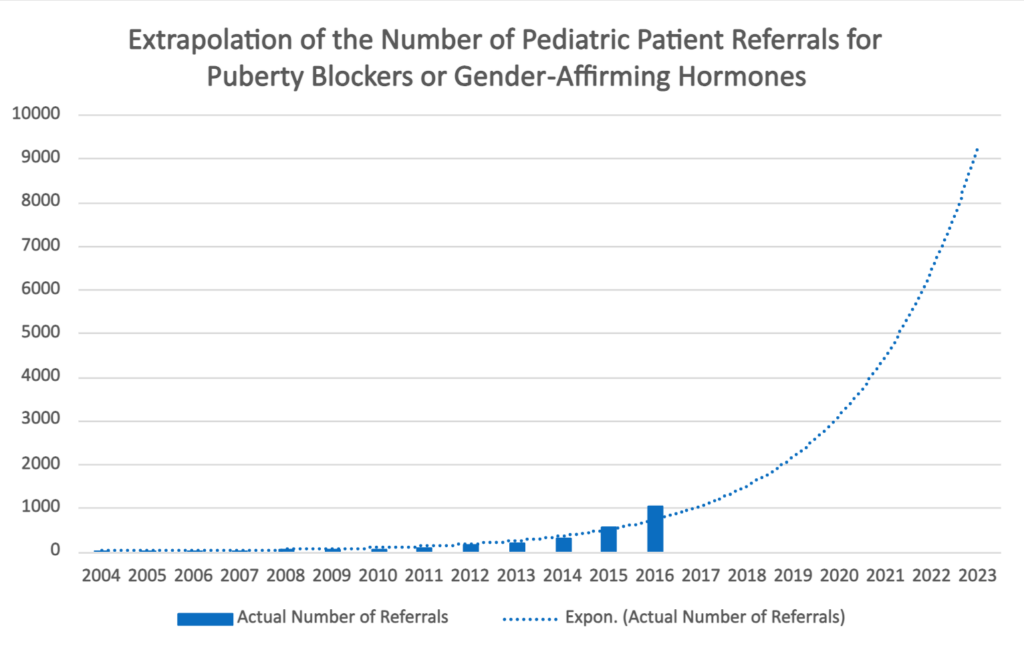In the last 10-15 years, we have all anecdotally sensed a rise of the transgender movement, with more and more people identifying as transgender, more media outlets talking about gender identity in their stories, and more politicians pledging their support for the LGBTQ2S+ movement. But what does the data say? How many people, and specifically children, are identifying as transgender and seeking a medical and then a surgical transition here in Canada?
The answer takes us down a windy road.
International Numbers
The beginning of the answer lies in the United Kingdom. For decades, the Tavistock clinic in the United Kingdom was the lone clinic in the country that specialized in treating children with gender dysphoria. The clinic initially began under the condition that their work with gender dysphoric children be part of a research study that would analyze the results of treating gender dysphoria in children. In other words, they were supposed to collect the data on the number of referrals to the clinic.

Image source: The Economist
But for years, they didn’t. Only after the Tavistock clinic imploded in public scandal and legal proceedings did the clinic go back through its archives and begin assembling the data required to start reviewing its work.
The Economist magazine was one of the first mainstream institutions to publish some of this data. Their data showed a 30-fold increase in referrals to Tavistock over the course of a decade, empirically validating what everyone was witnessing around them.
The collapse in the Tavistock clinic initially led to a leveling off in the number of minors referred to a gender clinic throughout the United Kingdom, leading some commentators to think that the country had begun to course correct in their treatment of gender dysphoria and that the exponential rise in the number of referrals had reached a ceiling.
That proved not to be the case. A few years later, the Society for Evidence-Based Medicine revealed that the number of referrals to gender clinics continued to rise rapidly in the network of gender clinics that opened across the country after Tavistock’s demise was in place. The rise continued and was mirrored in data from other countries such as Sweden.
So, the numbers of kids being referred to gender clinics for gender dysphoria has clearly skyrocketed in recent years in some Western jurisdictions. What about here in Canada?
Canadian Numbers
Collecting data on the number of minors diagnosed with gender dysphoria or going through a medical and surgical transition is difficult. Each province has their own health care system, and each province generally doesn’t publish their health service data. Thus, there has been a dearth of information on this issue in Canada.
For years, the best source of information was a study entitled “Trans Youth Can!” The study included participation from ten gender clinics across Canada (BC Children’s Hospital Gender Clinic in Vancouver, Alberta Children’s Hospital METTA Clinic in Calgary, Stollery Children’s Transgender Clinic in Edmonton, GDAAY Clinic in Winnipeg, LHSC Children’s Hospital Gender Pathways Service in London, McMaster Children’s Hospital Adolescent Medicine Clinic in Hamilton, SickKids Hospital Gender Clinic in Toronto, CHEO Diversity Clinic in Ottawa, Centre Meraki in Montreal, and IWK Health Centre Transgender Clinic in Halifax). Presentation slides from the study listed the number of referrals to specialist clinics for puberty blockers or gender-affirming hormones for nine Canadian clinics. No other information about these numbers accompany the graph, making it difficult to explore this data further.

Since 2016, the Trans Youth Can! study has not updated its figures for the number of referrals to gender clinics for puberty blockers or cross-sex hormones nor has there been another aggregation of referrals to gender clinics in other studies or data sources. However, extrapolating the data pattern presented in this Trans Youth Can! study would suggest that thousands of children are being referred for a medical transition. While it is unlikely that this trend continued without interruption through the COVID-19 pandemic and a growing number of figures urging caution when proceeding to a medical transition, this estimation can give us some idea of the magnitude of this issue.
Thankfully, one organization, the Canadian Institute for Health Information (CIHI), is dedicated to aggregating provincial-level health data and making it available for policy-makers, journalists, and citizens. Our team has requested data from CIHI regarding the number of minors who have medically and surgically transitioned.
Unfortunately, CIHI wasn’t able to provide us data on the number of referrals to gender clinics or puberty blockers or cross-sex hormones prescriptions. CIHI collects data primarily from public drug programs and claims that most puberty blockers and cross-sex hormone prescriptions are funded through private drug plans, and so they did not have the information available.
However, CIHI was able to release some data on the number of surgical transitions for minors. Thankfully, although there are no hard age requirements to go through a surgical transition in Canada, CIHI reports that there were less than five “bottom” surgeries (outside of Quebec, at least) between 2018 and 2023. While the fact that these procedures are legally allowed for minors is troubling, they seem to be extremely rare in Canada.
That premise does not hold true when it comes to “top” surgeries – mastectomies, the surgical removal of breasts. In the last five years, exactly 300 underage girls (outside of Quebec) had their breasts surgically removed to try to alleviate their gender dysphoria. That’s the equivalent of one every six days. According to reporting by Sharon Kirkey of the National Post, the youngest recipient of such as double mastectomy was 14. While we would like to get data on these surgical transitioning procedures prior to 2018, CIHI only disaggregated mastectomies for the purpose of transitioning from mastectomies for other reasons (e.g. breast cancer or cosmetic changes) starting in 2018.
And these numbers of “top” and “bottom” surgeries for minors doesn’t mean that the kids who did not receive these procedures are out of the woods. Many of them will choose or be encouraged to undergo these procedures as they enter adulthood.
Conclusion
As it stands right now, while we know that there are very few cases of “bottom” surgery on minors in Canada, dozens of “top” surgeries happen every year, and there are likely thousands of instances of minors being prescribed puberty blockers and/or cross-sex hormones as the default treatment for gender dysphoria. Every instance is a tragedy, the culmination of decades of misunderstanding about what human beings fundamentally are and what the purpose of medicine is.
Instead of medically transitioning children and surgically removing the healthy breasts of girls, we need to let kids be. Will you help us reach our provincial governments with the message that we need to end medical transitions for minors? Send an email to your provincial representative today!
